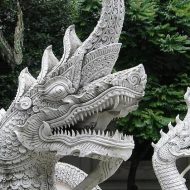Makara : The Elephant Crocodile
Listen
At a glance
| Description | |
|---|---|
| Origin | Thai Mythology |
| Classification | Hybrids |
| Family Members | N/A |
| Region | Thailand, Indonesia, India, Cambodia, Sri Lanka |
| Associated With | Protection, Water, Rain |
Makara
Introduction
A large and powerful dragon-like creature known as the Makara can be found carved from the walls and gateways of various temples and shrines in Indonesia, Thailand, and Bali. Its numerous teeth and bulging eyes scare away evil spirits. Various versions of the Makara are found in Indian, Thai, Cambodian, Sri Lankan and other South East Asian mythologies.
The Makara is regarded as an important deity in Buddhist and Hindu temple iconography, as it can protect various areas of the shrine, such as the entrance and throne rooms. It can also appear as a Gargoyle or a spout connected to a natural spring. In Hindu astrology, Makara is equivalent to the Zodiac sign Capricorn.
Physical Traits
This mythical creature is referred to as a sea creature that’s made up of various parts, such as an elephant, a crocodile, and a serpent. Usually, statues of the Makara feature a 5-headed Naga carved into its mouth. The snake or Naga is often shown to be being swallowed by the angry Makara or crocodile. The head of the Makara is usually shown as an elephant’s trunk with 3 ruffs on the side.
Family
The Makara is an aquatic servant of the powerful Vedic god, known as Varuna. In Vedic mythology, he was able to control the cosmos’ various means. The Naga is also an important part of the retinue of the god Varuna in Thai Hindu mythology.
Other Names
The Sanskrit word for crocodile, which literally means “sea-animal,” is the Makara. It’s also the origin of the Hindi word for the same creature, which is also known as the Mugger crocodile. According to German scientists and researchers, the makara is based on the dugong depiction found in the Jain text of Suryaprajapti. The South Asian river dolphin may have also contributed to the mythology of the makara. In Tibetan, the word “chu-srin” literally means “hybrid creature.”
Powers and Abilities
The Makara is regarded as an important deity in Hindu and Buddhist temples as it’s responsible for the various sources of water. Its depiction on the temple’s outer walls and ceilings is symbolic of the rising and falling of rain. It can also be seen as a link between the earth and heaven through a rainbow, which is a cosmic stairway made up of different colors.
Modern Day Influence
The presence of Makaras in Thailand symbolise the rich Hindu and Buddhist heritage that this island nation can lay claim to. With the growing influence of modern international influence and spread of Islam and Christianity in the island, the Makaras help the locals keep their ancestral beliefs alive. Even today traditional Thai architecture involves including the Makara on the staircases and entrances to most important places.
Related Images
Frequently Asked Questions
What does Makara mean?
Makara is a mythical sea creature found in Hindu mythology, often depicted as a hybrid of a crocodile or alligator combined with features of other animals like deer or elephants. It serves as the vehicle (vahana) of the river goddess Ganga and the sea god Varuna. Symbolically, Makara represents the balance between land and water, chaos and order. It is frequently used as a decorative motif in Hindu art and architecture. Overall, Makara embodies strength, power, and the mysterious qualities of the ocean.
Which God is Makara?
Makara is not a god but a mythical creature in Hindu mythology, serving as a vehicle (vahana) for several deities. It is most commonly associated with Ganga, the river goddess, symbolizing her connection to water and fertility. Makara is also linked to Varuna, the god of the oceans, representing the protective aspects of water. While it embodies strength and power, it is primarily a creature that highlights the relationship between divinity and the natural elements. Makara plays a significant role in the symbolism of Hindu art and culture.
Is Makara a dragon?
What does the Makara symbolize?
Makara symbolizes fertility, representing the life-giving properties of water and its importance in agriculture as a vehicle of the river goddess Ganga. It embodies protective qualities, acting as a guardian over water bodies and ensuring safe passage. The hybrid nature of Makara symbolizes the balance between land and water, reflecting the interconnectedness of natural elements. Additionally, it represents power and strength, showcasing the dual nature of water to nurture and destroy. As a decorative motif in Hindu art, Makara signifies beauty and complexity, highlighting its cultural significance.
Which God rules Makara Rashi?
Makara Rashi, also known as Capricorn in Vedic astrology, is ruled by the planet Saturn (Shani). In this astrological context, Saturn is associated with discipline, responsibility, and hard work. People born under Makara Rashi are believed to exhibit traits such as determination, practicality, and a strong sense of duty. Saturn’s influence emphasizes patience and perseverance, guiding individuals to pursue their goals with a structured and methodical approach.









